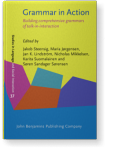Chapter 5
Structurally ‘incomplete’ social action formats in the grammar of
talk-in-interaction?
The case of deontic infinitives in spoken German
The chapter focuses on deontic infinitives, i.e., free
infinitives not governed by a matrix clause or an auxiliary; such
clauses have not been treated in German reference grammars because
they are considered syntactically incomplete. This chapter shows
that in contrast to similar practices for requests, directives, and
instructions (Gubina &
Deppermann frthc.), deontic infinitives implement
instructions of a normatively proper procedure or rule, which, in
most cases, applies both now and each time this
procedure is accomplished. The chapter discusses which features
(e.g., sequence and activity context, distribution of agency,
epistemic and deontic positionings, etc.) should be included in
reference grammars of talk-in-interaction and in current curricula
of German as Foreign/Second Language. The chapter concludes by
discussing possible challenges for creating a comprehensive grammar
of spoken language.
Article outline
- 1.Introduction
- 2.Theoretical background: Deontic infinitives and other
structurally ‘incomplete’ units in talk-in-interaction
- 3.Data and methods
- 4.Delimiting the phenomenon
- 5.Analysis
- 5.1Instructions for next steps within an activity
- 5.2Corrective instructions
- 5.3Changing tack after failed compliance with prior
requests
- 5.4Ambiguity of deontic stance and degree of obligation in deontic infinitives
- 6.Conclusion and discussion
- 6.1Summary and practical implications of the results of the
current study
- 6.2Some (possible) challenges and considerations for creating a comprehensive grammar
-
Acknowledgments
-
Notes
-
References
This content is being prepared for publication; it may be subject to changes.
